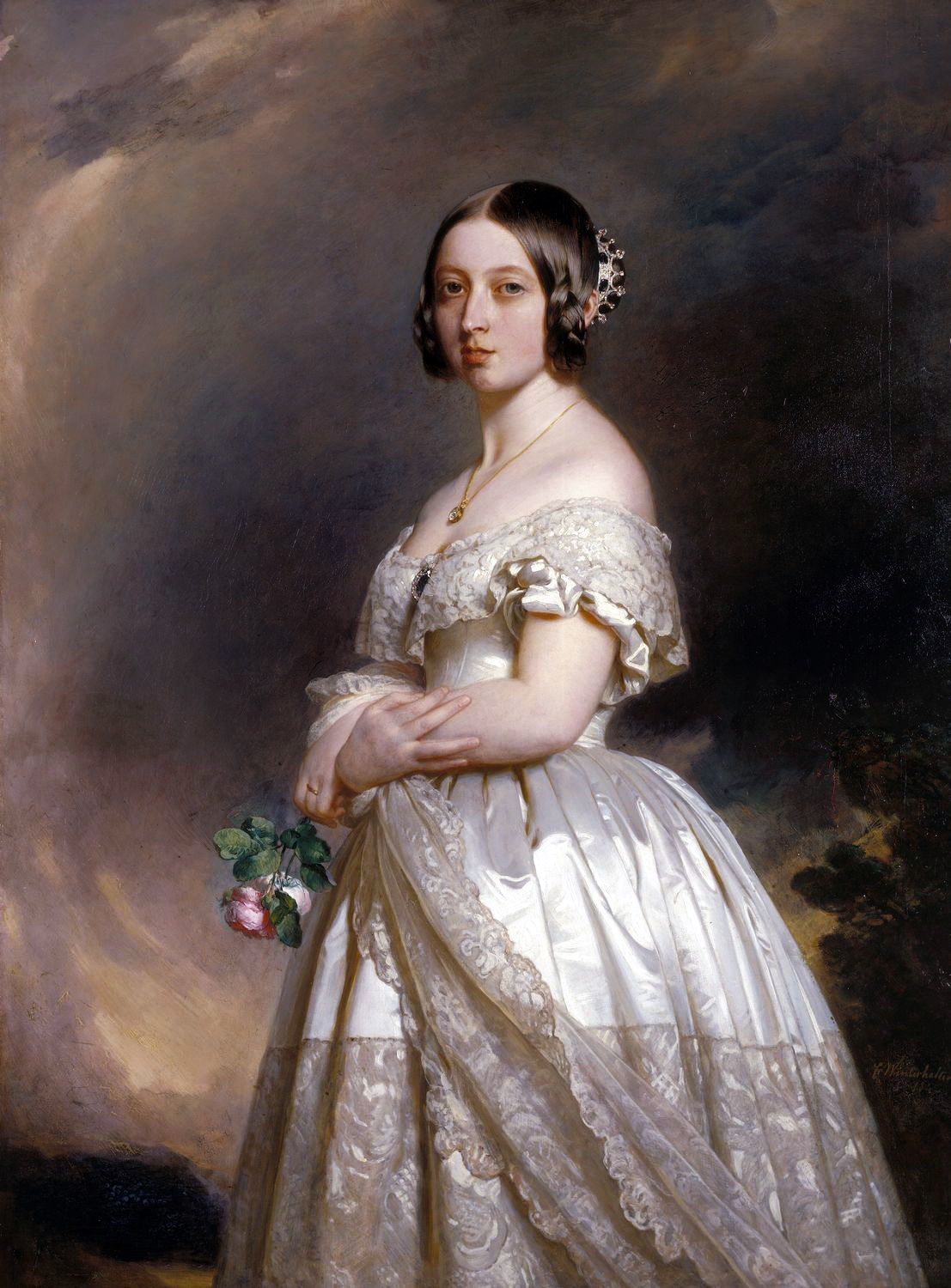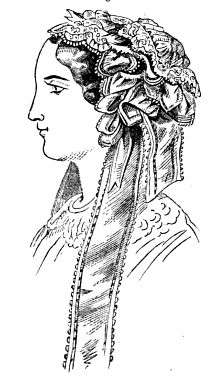Early Victorian era (1837-1860)
 |
| http://uploads7.wikiart.org/images/franz-xaver-winterhalter/queen-victoria-1842-1.jpg Portrait of Queen Victoria by Franz Xaver Winteralter c. 1842 Oil on canvas |
A home, I have created an early Victorian hairstyle based on the portrait of Queen Victorian on above. A sleek, clear middle parting is being seen on the top and plaits on the side extend to the back. A bun was created at the back. Because my practice head's hair is not long enough, so I can't wrapped the plaits around the bun and also as you can see on the photo, the bun is tiny at the back.
 |
| https://s-media-cache-ak0.pinimg.com/236x/5a/a3/c7/5aa3c762971d490bf3fe049b67a4ea6a.jpg Portrait of Mrs. Walters by George Frederic Watts (British, 1817-1904), 1840s Oil on canvas |
The portrait of Mrs Walters is an example of flat and sleek middle parting at the top and spiral curls on the side of the head.
Victorian women never cut their hair so they all had very long hair, but the only exception was that if she had got serious illness. During early Victorian era, center parting, tight curls were popular. The colour of the hair should suitable to their skin tones. Only black hair dye was available at that time and the reason Victorian ladies dyed their hair was because they wanted to cover up the grey hair; The hairstyle that they wore was: the top part of the hair was flat and smooth while one or more tight spiral curls or ringlets set closely to each side of the face. Sometimes, they did plaits rather than curls on the sides and the plaits created long loops, extended to the back of the hair and the top part of the ears were seen. Curls were also seen in men's hairstyles as well! Because Victorian ladies or women got very long hair, they usually tied up their hair into a bun shape or chignon at the back and it was sometimes tied up high but usually lower. Girls who were not engaged yet would wear their hair down and no hat and it symbolised eligibility of themselves. Pastes and lotions were used in Victorian era and they contained dangerous chemicals such as lead that could damage the hair or skin. As Victorian women care about their hair a lot, they put oil on their hair and used a long sausage curls to smooth the hair down. They used styling oils, creams or waxes to help their hair hold in place. Victorian women didn't washed their hair everyday because it was inconvenient as they have very long hair.
During 1848, Britain imported 8766 pounds of hair from France and so you can see Victorian cares about their hairstyles a lot and aiming for having beautiful hair. As Victorian thought long hair was envied and attractive, they wore extensions and hair pieces. The supplying of artificial hair had become a major industry around 1859 and there was an article in the Irish Quarterly Review written that ' In no country in the world is more attention paid to the hair than in Great Britain'.
Mid to Late Victorian era (1860-1890)
 |
| https://blogger.googleusercontent.com/img/b/R29vZ2xl/AVvXsEhQdSl8jrjIRG9Dk_ClCRSar72fvbe5FsRO6YdXLzoVujoLw918J6zq-LeQfIF6I_fDsHQTX2WtP_hzxDurP5x8KR15qurosFMvY3C4k3ldBP6PrPAEhFhkjIRc8j38lkWVXGZW53PXfy2z/s1600/victorian-hairstyles.jpg Late Victorian Hairstyles |
As you can see the two photos from above, on the first photo, the side curls were more loosed than early Victorian times and later on, on the second photo, in the 1870's, the side curls were disappeared and also same with the middle parting. The curls started to move upwards and the curls were moved to the back of the hair. Some of the loose curls were leaved down as well and the hair also become more fluffy. At the back of the hair were usually placed in a chignon,curls and braid and sometimes, there were small curls around the forehead. Crimping became popular in the early 1870's and during 1872, the French hairdresser, Marcel Grateau had introduced the Marcel wave and it is a heated iron which creates curls.
 |
| https://s3-eu-west-1.amazonaws.com/rbi-communities/wp-content/uploads/mt/hairdressersjournalweb/blogs/2012/05/03/photos/marcel-grateau-hairdresser.jpg |
- Soap and water
- “If you want to have a good head of hair, never apply to cosmetics; use nothing else to clean it but strong, cold black tea. Rub it into the roots every evening before going to bed, with a little sponge, and every morning do the same. I generally use it, and recommend it to all ladies desirous of having a full head of hair” – pg. 261, Godey’s Lady’s Book (September 1867).
- “To cleanse long hair – beat up the yelk of an egg with a pint of soft water. Apply it warm, and afterwards wash it out with warm water” – pg.458, Godey’s Lady’s Book (printed 1869).
- “The yolk of an egg beaten up in warm water is an excellent application to the scalp” – pg. 317, Decorum (1879).
- "Vinegar and water form a good wash for the roots of the hair” – pg. 316, Decorum (published 1879).
- “Any preparation of rosemary forms an agreeable and highly cleansing wash” – pg. 317, Decorum (1879).
- Brushing
There are comments from the Victorians about recipes for hair treatments such as on below:
A recipe for Hair loss or thinning hair
answer to a reader in The Young Ladies' Journal, 1873
Judy: Try rum and castor oil mixed in equal parts, shaken together, and rubbed into the roots of the hair at night. It is stimulating and nourishing.
Lightening hair and hair washes
to another reader in The Young Ladies' Journal, 1873
Pollie's Own: Washing you hair with soda will make it ligter; but it is injurious to the skin of the head and causes the hair to break. Roesmary is very beneficial and is used as a wash.
The book, "The arts of beauty; or secrets of a lady's toilet, with hints to gentlemen, on the art of fascinating" by Lola Montez, Harvard College Library,1891 had recipes to color the gray hair: "10 grams of gallic acid, 1 ounce of acetic acid y 1 ounce of tincture of sesqui-chloride of iron. Dissolve the gallic acid in the tincture of sesqui-chloride of iron, and then add the acetic acid. Before using this preparation, the hair should be thoroughly washed with soap and water. A great and desirable peculiarity of this dye is that it can be so applied as to color the hair either black or the lighter shade of brown. If black is the color desired, the preparation must be applied when the hair is moist, and for brown it shall not be used until the hair is perfectly dry. The way to apply the compound is to dip the points of a fine tooth comb into it until the interstices are fill with the fluid, then gently draw the comb through the hair, commencing at the roots, till the dye has perceptibly taken effect. When the hair is entirely dry, oil and brushes it as usual ".
Headdress
The more elaborately decorated headdress that a person wore, the more wealthy the person was. The headdress was also a symbol of status in society and wealth during the Victorian times.
Bonnets |
| https://s-media-cache-ak0.pinimg.com/236x/c4/04/91/c404917b338bf3fe480987a3909f7419.jpg Godey's Lady's Book, 1864 |
Dress cap
 |
| http://www.reusableart.com/miwp/wp-content/uploads/2014/03/hat-image-04.jpg Godey's Lady's Book 1854 |
 |
| https://s-media-cache-ak0.pinimg.com/236x/99/77/0d/99770d2e2f8e2d4eb1b47194a9447eee.jpg |
Bandeaux and pearl comb
 |
| https://s-media-cache-ak0.pinimg.com/736x/e5/68/fb/e568fbd33038045e24b171c57e82ff18.jpg Godey's Lady's Book, February 1856 |
Wide ribbons and golden leaves
The ribbons were made up into bows and the end part falling almost to the shoulders. Golden leaves were also used for headdress as well.
 |
| http://www.vintagevictorian.com/images/1854-1_g_b.jpg |
 |
| https://s-media-cache-ak0.pinimg.com/originals/e4/ec/55/e4ec5549b7cbbd0e58738e3c22b35056.jpg |
Book references:
- Richard Corson (2005). Fashion In Hair- The First Five Thousand Years. Peter Owen Publishers.
- Richard Corson (2010). Fashion In Makeup - From Ancient To Modern Times. Revised Edition, third edition, Peter Owen Publishers.






No comments:
Post a Comment